- 7 Top Flite Golf Clubs XL for Improved Performance - September 28, 2024
- Top Flite Golf Clubs: Top 5 Reasons to Choose Them - September 28, 2024
- Top 3 Golf Club Fitters for a Perfect Swing - September 28, 2024
You might think that splurging on fancy golf clubs will drastically improve your game, but the truth is, it's your swing technique that makes the biggest difference. While modern iron design and technology can enhance ball-striking consistency, distance control, and accuracy, the impact of club quality is relatively small – we're talking a 5-7 yard difference between a $400 driver and a $1,000 driver. That being said, choosing the right club for your swing style and skill level can still give you an edge. Want to learn how to get the most out of your clubs and shave strokes off your score?
Key Takeaways
- While modern golf clubs can provide some benefits, such as increased forgiveness and accuracy, the impact of club quality is relatively small.
- A golfer's skill level and swing technique have a much greater influence on performance than the quality of their golf clubs.
- Even professional golfers can adapt to playing with lower-quality clubs, and swing technique is the most vital factor in determining results.
- The difference between a high-end club and a lower-end club is relatively small, with a study finding a 5-7 yard difference between a $400 driver and a $1,000 driver.
- Ultimately, it is the skills and techniques of the golfer that drive results, and club quality plays a secondary role.
Do New Irons Make a Difference?
When you upgrade to new irons, you might wonder whether they'll substantially impact your game, and the answer lies in understanding how modern iron design and technology can affect your swing and overall performance.
A new set of irons can markedly influence your ball-striking consistency, distance control, and overall accuracy.
Modern irons often feature advanced materials, such as titanium or high-strength steel, which enable faster ball speeds and increased forgiveness.
Additionally, innovative designs like hollow-body constructions and precision-engineered clubheads can optimize weight distribution, leading to more consistent swings.
With a new set of irons, you can expect improvements in your short game, particularly with shots requiring high precision and control.
The increased forgiveness and accuracy can also help you maintain a consistent swing tempo and reduce the likelihood of slicing or hooking.
By taking advantage of the latest iron technology, you can refine your swing and develop a more confident and consistent game.
Is It the Club or the Golfer?
As you consider the impact of golf clubs on your game, you must acknowledge that your skill level plays a significant role in the outcome.
You'll find that high-quality clubs can make a difference, but they won't compensate for poor technique or a lack of practice.
When evaluating the effectiveness of your clubs, you must also examine your swing style and overall approach to the game.
Golfer's Skill Level Matters
Your golf swing's weaknesses and strengths greatly influence the overall performance you get from your clubs, making it essential to assess your skill level before attributing blame or credit to your equipment.
As a golfer, you know that your technique has a significant impact on your game. A golfer's skill level matters, and it's vital to recognize that your abilities, or lack thereof, play a significant role in the outcome of your shots.
A consistent swing is key to getting the most out of your clubs. If you're inconsistent, even the best clubs won't compensate for your flaws.
Your swing speed and tempo affect the distance and accuracy of your shots. If you're struggling with control, it's not necessarily the club's fault.
Your ability to strike the ball cleanly and solidly has a direct impact on the result. If you're not making clean contact, no club can fix that.
Club Quality Has Impact
While recognizing the importance of your skill level, it's also important to acknowledge that club quality can indeed make a difference in your game, but to what extent?
Research suggests that the impact of club quality is relatively small. A study by the USGA found that the difference in distance between a $400 driver and a $1,000 driver is only about 5-7 yards.
Even professional golfers can adapt to playing with lower-quality clubs, as evidenced by a study that found that pros could still shoot under par with inferior equipment.
Despite this, 75% of golfers believe that the quality of their clubs has a significant impact on their game, but this perception may be exaggerated.
In reality, your swing technique is the most vital factor in determining your performance, with club quality playing a secondary role. As you consider the role of club quality in your game, remember that it's your skills and techniques that ultimately drive your results.
Swing Style Is Key
Precision in your swing style is what separates a good golfer from a great one, and it's the key factor that determines whether you'll hit a birdie or a bogey.
While a quality club can enhance your game, it's your swing style that ultimately decides the outcome. You can have the most expensive, high-tech club in the world, but if your swing style is off, you'll still struggle to hit consistent shots.
Three key aspects of your swing style impact your game:
Ball position: Where you position the ball in relation to your stance affects the trajectory and distance of your shots. Experiment with different ball positions to find what works best for you.
Swing tempo: Your swing tempo, or the speed at which you swing the club, affects ball speed and control. Find a tempo that allows you to maintain control while still generating power.
Angle of attack: The angle at which you strike the ball determines the height and spin of your shots. A shallow angle of attack produces a higher, softer shot, while a steeper angle produces a lower, more penetrating shot.
Choosing the Right Club Matters
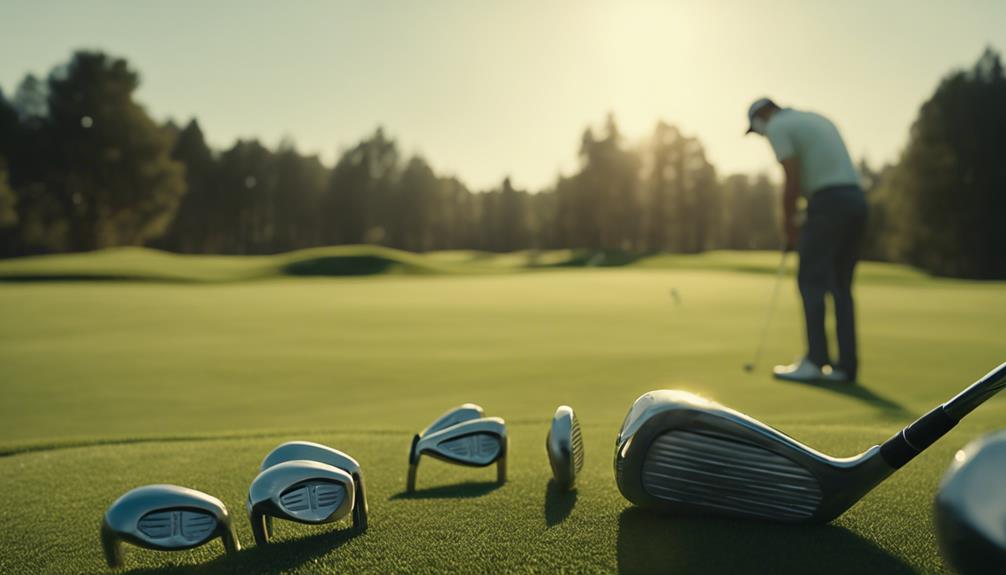
When you're selecting a golf club, you're making a vital decision that can profoundly impact your game.
You need to examine the club's specifications, as they can either enhance or hinder your performance.
Club Head Material Matters
You'll likely notice that golf clubs with different club head materials perform distinctly, and understanding these differences is essential to choosing the right club for your game. The club head material can greatly impact the feel, sound, and overall performance of your shots.
When it comes to club head materials, you'll typically encounter three main options:
- Forged irons: Known for their soft, responsive feel and precise control, forged irons are a popular choice among skilled golfers. They're often more expensive, but offer a level of precision and workability that's hard to match.
- Cast irons: Cast irons are more affordable and forgiving, making them a great option for mid-to-high handicappers. They tend to produce a slightly hotter ball flight and offer more distance.
- Hybrids: Hybrids combine the forgiveness of fairway woods with the precision of irons. They're an excellent choice for golfers who struggle with long irons or need extra help getting the ball airborne.
Loft Angle Affects Flight
How do you guarantee the right club is in your hands to achieve ideal flight and distance, considering the vital role loft angle plays in determining the trajectory of your golf ball?
The answer lies in understanding how loft angle affects flight. With higher lofts, you'll see higher trajectories and shorter distances. But it's not just about the loft angle itself – your swing speed, launch angle, and spin all play a key role in determining the ideal loft for you.
As a golfer, you need to take into account your individual swing characteristics to find the perfect loft angle.
For example, if you have a slower swing speed, you'll want a higher loft to achieve maximum distance and trajectory. Even professional golfers like Dustin Johnson customize their loft angle to suit their unique swing.
Remember, it's not just about swing speed – launch angle and spin are more important factors in finding the right loft.
Shaft Flex Impacts Swing
Your golf swing's tempo, changeover, and release are all influenced by the shaft flex, which can either hinder or enhance your overall performance, depending on the right club choice.
When you choose a shaft flex that matches your swing characteristics, you'll experience a more consistent and controlled swing. On the other hand, a mismatch can lead to poor timing, loss of distance, and inconsistent ball-striking.
Swing speed: If you have a faster swing speed, you'll benefit from a stiffer shaft flex to maintain control and reduce twisting. Slower swing speeds require more flexible shafts to generate more power and distance.
Swing style: If you have a smooth, tempo-driven swing, a more flexible shaft flex can help you maintain a consistent rhythm. Aggressive, forceful swings require stiffer shafts to counteract the added torque.
Ball flight: The right shaft flex can help you achieve your desired ball flight. For example, a more flexible shaft can produce a higher, more forgiving trajectory, while a stiffer shaft can generate a lower, more penetrating ball flight.
Modern Technology Gives an Edge
With the advent of modern technology, golf clubs have undergone a significant transformation, allowing golfers to tap into unprecedented levels of power and precision.
In modern golf, expensive equipment has become a significant factor in achieving superior results. The latest clubs have a larger margin for error, enabling you to focus on raw power over accuracy.
This is evident in the PGA Tour, where the average driving distance has increased by almost 40 yards since 1980. Newer clubs also offer better results even on off-center hits, with solid-centered strikes producing good results with almost any club from the last decade.
The reduced spin variance in the latest golf balls and clubs leads to more consistent shots. Upgrading to newer clubs can lead to significant performance gains, such as the TSR2+ fairway wood, which achieves greater separation between launch and spin, resulting in increased distance and consistency.
Club Condition Affects Performance
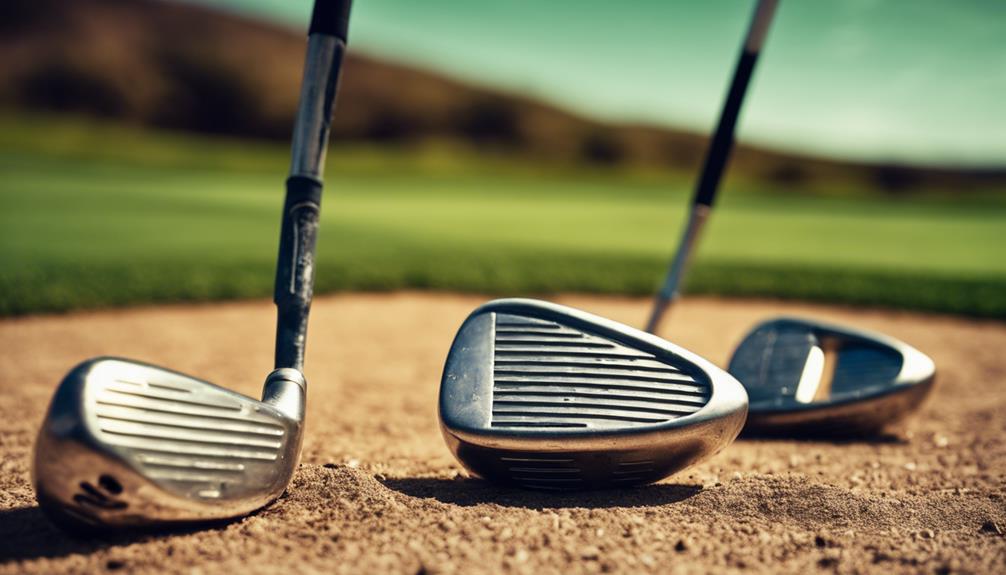
By neglecting to properly maintain their golf clubs, golfers can unwittingly compromise their performance on the course.
You invest time and effort into perfecting your swing, but if your clubs are in poor condition, it's all for naught.
The state of your golf equipment can profoundly impact your game, and it's vital to prioritize club maintenance.
Cleanliness is key: Regularly cleaning your club face guarantees dirt and debris don't interfere with your shot, and prevents corrosion and rust.
Storage matters: Properly storing your clubs with headcovers in a dry, temperature-controlled environment prevents damage and maintains their condition.
Regular maintenance is essential: Re-gripping, sharpening grooves, and applying a wax finish can elevate your play and extend the lifespan of your clubs.
Debunking Common Golf Club Myths
Many golfers mistakenly believe that investing in high-end golf clubs is the key to improving their game, but the truth is that even the most expensive clubs won't compensate for a lack of skills and knowledge.
You might think that buying new golf clubs will instantly boost your performance, but it's not that simple. The make and model of your clubs aren't as important as your ability to choose the right club for each shot and know the distances of each club.
In reality, it's the golfer who determines the results, not the clubs. Working on your swinging fundamentals, learning club distances, and taking care of maintenance is what leads to improvement.
Don't fall for the myth that expensive clubs will magically fix your game. Instead, focus on developing your skills and getting fitted for the right clubs that suit your needs. With the right approach, you can excel even with mediocre clubs.
Does Club Quality Impact Score?
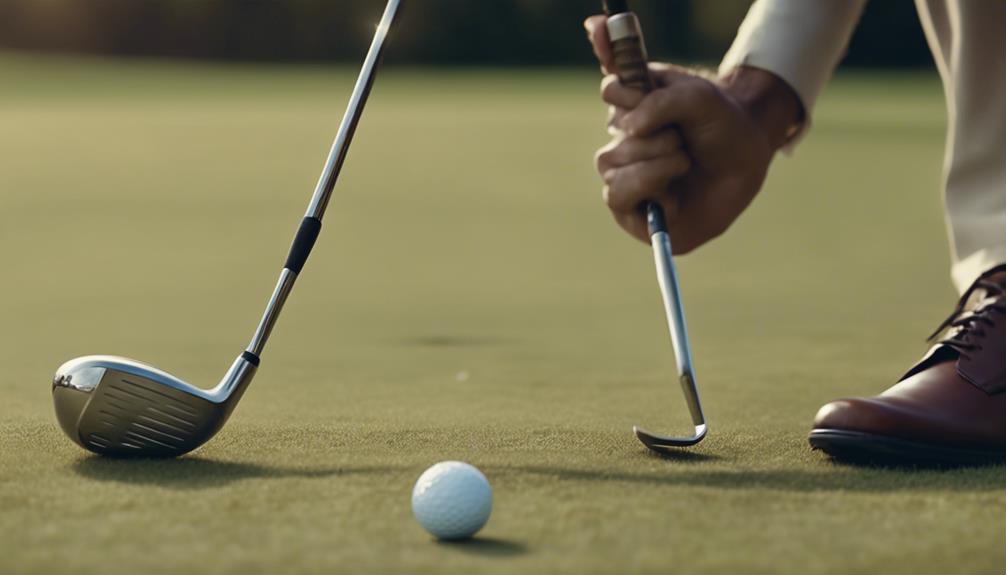
One key question on every golfer's mind is: can investing in higher-quality clubs really make a tangible difference in your score?
The answer is a resounding yes. The quality of your golf clubs can profoundly impact your score, with better clubs providing more forgiveness, distance, and consistency, leading to lower scores.
Upgrading to higher-quality clubs can result in an average improvement of 3.5 strokes per round, with better players seeing even greater improvements.
High-end clubs often feature advanced materials and technologies, such as titanium faces and adjustable clubheads, which can provide a substantial advantage over lower-end clubs.
Even small enhancements in club quality, such as upgrading from a low-end to a mid-range club, can result in a notable difference in score, with an average improvement of 1.8 strokes per round.
How Often Should I Replace Clubs?
You should replace your golf clubs regularly to guarantee peak performance and prevent hindrances to your game.
As a frequent player, you'll need to replace your irons more often due to wear and tear. PGA Tour pros, for instance, replace their irons after every season. While you may not need to do so, regular assessments of your irons' condition are crucial.
If you've improved your skill level and your current irons are holding you back, it's time for an upgrade. Outdated irons with old technology can hinder your game, and replacing them with modern ones can make a significant difference.
Look out for signs like excessive spin, loss of height, and poor divot patterns, which indicate the need for new irons. The lifespan of your irons also depends on frequency of play, damage, and quality.
If you notice cracks or wear on your irons, think about getting new clubs. By replacing your irons regularly, you'll maintain top-notch performance and prevent further damage to your clubs.
What Makes New Clubs Better?
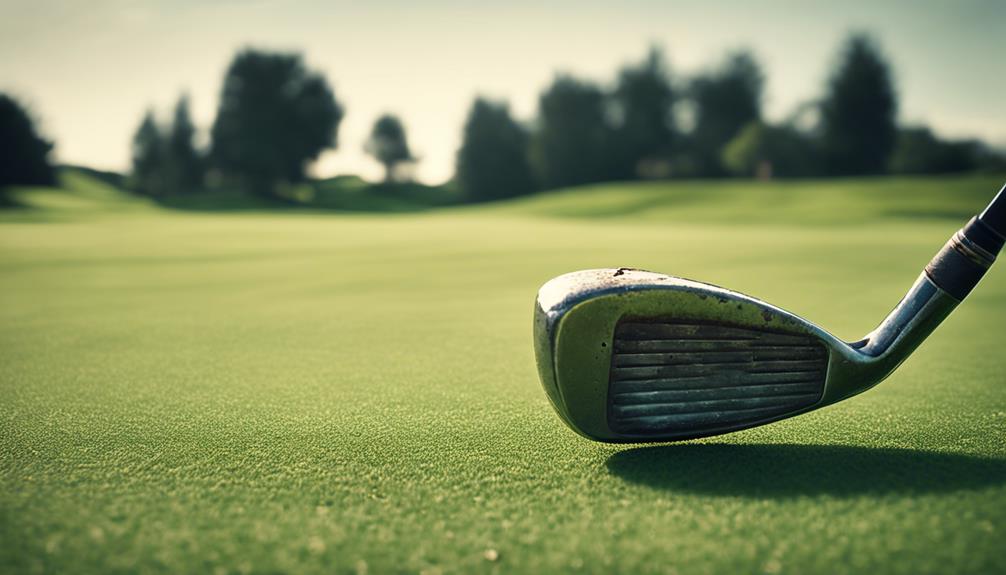
When you consider upgrading your golf clubs, you'll notice significant advancements in clubhead design, materials, and shaft technology.
You'll find that modern clubs boast lighter yet stronger components, allowing for more flexibility and precision in your swing.
Clubhead Design Evolves
Advanced manufacturing techniques and cutting-edge materials have revolutionized clubhead design, enabling the creation of more forgiving, accurate, and powerful golf clubs that cater to a wide range of swing styles and preferences.
As a golfer, you can take advantage of these advancements to improve your game.
Modern clubheads have evolved to provide a larger sweet spot, resulting in more consistent ball flights and increased forgiveness for off-center hits.
New clubhead designs feature improved aerodynamics, which reduces drag and allows for faster clubhead speeds, resulting in increased distance and accuracy.
The introduction of adjustable clubheads has given you the ability to customize your clubs to fit your individual swing style and preferences, leading to improved performance and consistency.
These innovations have led to significant improvements in clubhead design, allowing you to achieve better results on the course.
With the help of advanced materials and computer-aided design, manufacturers have optimized clubhead shape, size, and weight distribution, resulting in more efficient energy transfer and improved ball flight.
Materials Get Lighter Stronger
As clubhead design continues to evolve, the materials used to craft these components have become increasingly sophisticated, with modern golf clubs benefiting from cutting-edge materials that prioritize strength, lightness, and durability.
You'll notice a significant difference when using expensive, newer clubs that incorporate these advanced materials. For instance, TaylorMade's one-piece forged irons undergo an extra forging process to enhance feel, resulting in a more consistent and responsive clubhead.
Titleist takes it a step further by using aerospace-grade titanium ATI425 in their TSR drivers, which was originally developed for industries like aerospace and defense. This allows for a stronger and lighter clubhead.
Callaway's partnership with Lamborghini has also led to the introduction of forged composites in their Diablo Octane driver, enabling the creation of a stronger and more forgiving clubhead.
These new materials allow engineers to save weight and redistribute it for improved clubhead stability, resulting in faster ball speeds and more consistent shots. By leveraging advancements in materials engineering from industries like aerospace and automotive, golf club manufacturers can create high-performance clubs that give you a competitive edge.
Shafts Become More Flexible
Modern shafts are designed to be much more flexible than their predecessors, allowing golfers with a wide range of swing speeds and styles to achieve peak performance. This increased flexibility is made possible by advancements in materials, such as graphite and titanium, which provide strength and flexibility simultaneously.
The flexibility of shafts is measured in cycles per minute (CPM), with lower CPM indicating a more flexible shaft.
Shafts with lower CPM (around 200-220) are suitable for slower swing speeds and provide more forgiveness. Shafts with higher CPM (around 250-260) are better suited for faster swing speeds and offer more control. Custom fitting is vital to finding the right shaft for your swing, as it can profoundly impact your overall performance.
With modern shafts, you can take advantage of the benefits of flexible shafts, including increased forgiveness and control. By understanding your swing speed and style, you can find the perfect shaft to optimize your game.
Golf Club Materials and Treatments
By leveraging cutting-edge materials and treatments, golf club manufacturers can substantially enhance the performance, forgiveness, and feel of their products.
You'll find advanced materials like aerospace-grade titanium ATI425 in drivers, which boosts ball speed and distance. Forged composites, developed in partnership with Lamborghini, enable the creation of complex shapes and structures that reduce weight and increase clubhead speed.
These innovative golf club materials allow engineers to save weight and redistribute it for improved clubhead stability, leading to more consistent and accurate shots. Additionally, some manufacturers employ an extra forging process to enhance feel, resulting in a more consistent and responsive strike.
The use of advanced materials and treatments in golf clubs enables manufacturers to create products with improved performance, forgiveness, and feel, resulting in better overall gameplay. As you explore the world of golf clubs, you'll discover how these cutting-edge materials and treatments can elevate your game.
Selecting the Best Irons for You
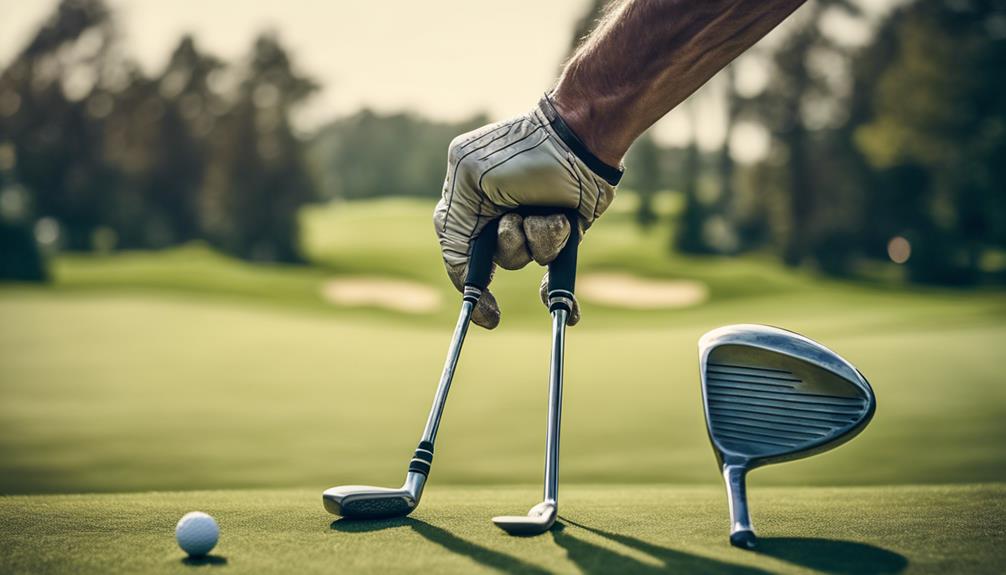
When it comes to taking your game to the next level, selecting the right set of irons is essential, and it all starts with understanding your individual needs and preferences. As a golfer, you want to verify that your irons are tailored to your skill level, swing speed, and personal style.
Shaft flexibility: Choose a shaft that matches your swing speed and skill level, with stiffer shafts for faster swings and more flexible shafts for slower swings.
Material selection: Steel shafts offer durability and affordability, while graphite shafts provide a lighter, more expensive option.
Fitting and customization: Get your irons fitted to your swing to optimize distance, accuracy, and consistency.
Some key factors to examine when selecting the best irons for you:
- Shaft flexibility
- Material selection
- Fitting and customization
Frequently Asked Questions
How Do I Choose Between Golf Clubs?
When selecting golf clubs, you'll want to take into account your golf style, personal preference, and swing speed to find the perfect fit, ensuring a consistent and confident game, so take your time to research and compare sets.
How Can You Tell the Difference Between Golf Clubs?
When evaluating golf clubs, you can tell the difference by examining material quality, noticing how it affects weight distribution and overall feel, and paying attention to sound feedback, which varies between clubs, indicating a sweet spot or mishit.
When Should You Use Different Golf Clubs?
When playing, you'll need to adapt to course conditions and adjust your club selection based on your swing style; for instance, use a hybrid in windy conditions or a wedge for tight lies, optimizing your game.
What Is More Important, the Club Head or the Shaft?
Can you really blame the shaft for a bad shot? When it comes to club performance, you focus on the club head design, as it dominates ball flight and launch conditions, while shaft flexibility dynamics play a subtle, supporting role.
Conclusion
As you navigate the complex world of golf clubs, remember that upgrading to the right set can be like finding the missing piece to a puzzle – suddenly, everything clicks into place.
New irons can make a tangible difference in your game, offering improved accuracy, distance, and control.
By understanding the role of modern technology, club condition, and materials, you'll be better equipped to choose the perfect clubs for your unique swing, taking your game to the next level.




